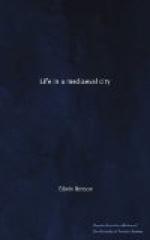Condemned heretics were burnt[2] at Tyburn, the site of local executions, some way from Micklegate Bar along the main south road.
B. PARLIAMENTARY AND NATIONAL LIFE
According to the general principle, the King was the ultimate and absolute owner and ruler of the land and people. The rights, liberties, customs, and powers possessed by individuals and corporate bodies were specified parts of the royal power which the King had granted on some consideration or other. Thus, knights, archbishops, and nobles received lands and rights in return for the provision, when required, of military service by themselves and a certain force of their retainers, except that no personal military service was required from the archbishop from the very nature of his calling. The monasteries and other Church institutions had many possessions and rights. The Church, which was established in the realm before Parliament, was a very great owner of land. The authorities of cities, with their trade-guilds, received the right of trading, or holding markets, and of levying tolls or municipal taxes. They received also the right of making their own local laws or bye-laws. These authorities, whether individuals or corporate bodies, to whom rights and liberties were granted, had their own officers and laws controlling their liberties. Besides the King’s peace, there were, therefore, the jurisdictions of these various rights granted from the supreme royal authority.
[Illustration: KNIGHTS DOING PENANCE AT A SHRINE. From a Fifteenth-Century Manuscript.]
From York there went to the national Parliament the lord Archbishop of York, the lord Abbot of St. Mary’s Abbey, those nobles who resided in the city and were Lords Temporal, and the two representatives of the commonalty of the city. The body of Lords Spiritual was of great importance in the Middle Ages. The Convocation of the lords of the Church had itself a share in the governing of the nation as well as of the Church, its own particular sphere. The Church was one of the most powerful and richest factors in national affairs. The clear division of the Parliament of the Middle Ages into three groups reflects the sharp divisions that there were between the three great classes of the nation—the nobles, the clergy, the people.
In the fifteenth century, as in other centuries, York was frequently visited by the King. From time to time, as when the King and Court proceeded north during the wars with Scotland, Parliament was moved to York, where it was held in the Chapter House of the Minster. Six of the seven windows of the Chapter House contain their original stained glass, in which appear shields of King Edward I. and members of the Court. The Chapter House was used as a Parliament house during the reigns of the first three Edwards. The King, in mediaeval times, was actual commander-in-chief, and it suited him well for Parliament to meet in the political capital of the north, so that he could continue the civil administration while conducting warfare in the north.




